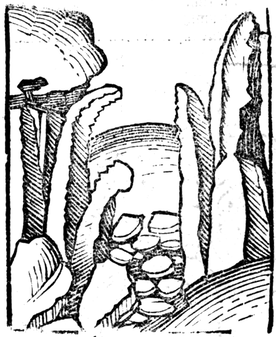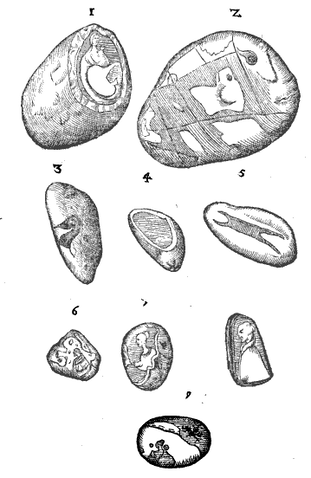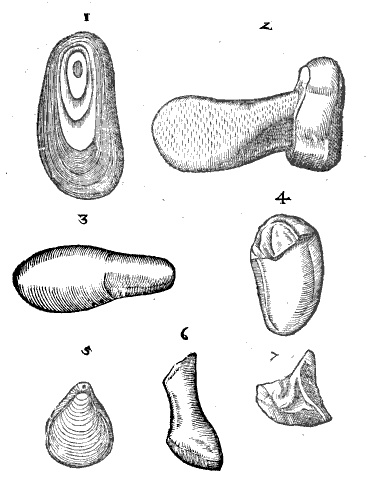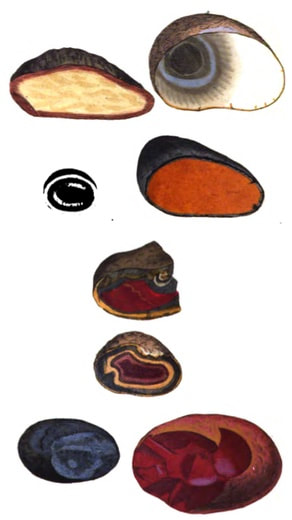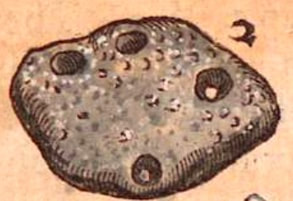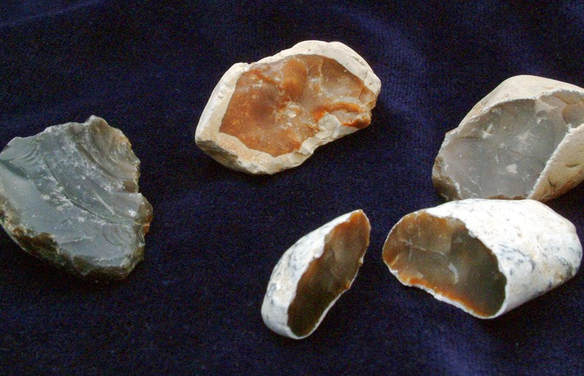Sentry Page Protection
Flint
Silex, Lapis Tiliceus
Naturally perforated Flint is called Holy Stone, Hag Stone, Witches Stone, Silex Pertusus ('perforated Flint')
Naturally perforated Flint is called Holy Stone, Hag Stone, Witches Stone, Silex Pertusus ('perforated Flint')
Ortus Sanitatis, Beck, 1517
Varieties of Flint from
Aldrovani, Musaeum Metallicum, 1648
Aldrovani, Musaeum Metallicum, 1648
Varieties of Flint
British Mineralogy, Sowerby, 1811
British Mineralogy, Sowerby, 1811
Silex pertusus, Naturally Perforated Flint, 'Hag Stone'
Conradi Gesneri de Rerum Fossilium Lapidum et Gemmarum, 1565
Conradi Gesneri de Rerum Fossilium Lapidum et Gemmarum, 1565
Mineralogical name:
Crypto-crystalline quartz
Parts used:
‘Some are Black, some Cloudy, some White’ (Salmon); the ‘White Flints of the River’ were often called for, but in making the Liquor, Pale Yellow, Green or Blue stones were preferred. The best were said to be those which contain Gold.
Temperature & Taste:
Cool, dry. Pungent
Classifications:
‘Discussive, digestive, resolutive’.
Properties:
Hardness: 6-7
Specific Gravity: 2.59-2.6
Chalcedony is a cryptocrystalline form of Quartz, and is of the Trigonal crystal system;
Luminescence: Yellow, yellow-green, or white.
Readily soluble in alkaline solutions, especially KOH.
Crypto-crystalline quartz
Parts used:
‘Some are Black, some Cloudy, some White’ (Salmon); the ‘White Flints of the River’ were often called for, but in making the Liquor, Pale Yellow, Green or Blue stones were preferred. The best were said to be those which contain Gold.
Temperature & Taste:
Cool, dry. Pungent
Classifications:
‘Discussive, digestive, resolutive’.
Properties:
Hardness: 6-7
Specific Gravity: 2.59-2.6
Chalcedony is a cryptocrystalline form of Quartz, and is of the Trigonal crystal system;
Luminescence: Yellow, yellow-green, or white.
Readily soluble in alkaline solutions, especially KOH.
Uses:
1. Promotes Urine, Opens Obstructions:
-stopped or obstructed Urine, Edema
-dissolve and clears Stones;
-Hypochondriac pain, Liver obstruction
-they were used as a talisman to prevent back ache
2. Clears Heat:
-Fever, Heat disease
3. Clears Phlegm:
-Dissolves the Tartarous mucilage in the Lungs. (Salmon)
Dose
Decoction: half–1 oz.
Levigated Powder: 125–250mg, up to 500 or 1000mg.
Bhasma: 125–250mg, up to 500mg.
Comment:
'Hag Stones' or 'Witches Stones', also called Silex Pertusus, are naturally occurring perforated Flint stones and were used in Magic. Hung around the bed head or kept under the pillow to protect from Nightmares, they were also believed to protect from the Evil Eye, against Poison, and Witchcraft. They were generally regarded as protective and were used to protect children, homes and even boats and horses.
Preparation:
1. They are heated to red hot and quenched in water or wine; repeat this so often until they fall to a calx, which will be after 3 or 4 times.
This is good to promote Urine, and clear Stones.
2. White flints are heated red hot, then quenched in water into which Ammonium chloride has been dissolved until they may easily be powdered; make a very subtle powder, then form into pills with Rose Water. These are used to promote urine when stopped, or in Edema, and for Stones. Dose: 10-20 grains (Bateana);
3. Hartman has a similar version where they are heated and quenched in Wine and repeated until they crumble.
Decoction: half–1 oz.
Levigated Powder: 125–250mg, up to 500 or 1000mg.
Bhasma: 125–250mg, up to 500mg.
Comment:
'Hag Stones' or 'Witches Stones', also called Silex Pertusus, are naturally occurring perforated Flint stones and were used in Magic. Hung around the bed head or kept under the pillow to protect from Nightmares, they were also believed to protect from the Evil Eye, against Poison, and Witchcraft. They were generally regarded as protective and were used to protect children, homes and even boats and horses.
Preparation:
1. They are heated to red hot and quenched in water or wine; repeat this so often until they fall to a calx, which will be after 3 or 4 times.
This is good to promote Urine, and clear Stones.
2. White flints are heated red hot, then quenched in water into which Ammonium chloride has been dissolved until they may easily be powdered; make a very subtle powder, then form into pills with Rose Water. These are used to promote urine when stopped, or in Edema, and for Stones. Dose: 10-20 grains (Bateana);
3. Hartman has a similar version where they are heated and quenched in Wine and repeated until they crumble.
Main Combinations:
Cautions:
Standard cautions for using Gem stones.
Main Preparations used:
1. SALT of FLINTS.
Calcined Flint
Extract the Salt with Vinegar, or distilled vinegar; then filter, and evaporate to dryness. This may then be left to dissolve into an oil in a cool cellar. It powerfully dissolves and expels Stones.
Dose: 6-15 drops. (Salmon)
2. OIL or LIQUOR of FLINTS.
(Solution of Potassium Silicate)
Made of the Salt per Deliquium.
It has the virtues of the Salt, and is given in the same dose. It cuts ‘Tartarous Mucilage’, opens obstructions, and resolves stones. This Oil is of a Golden nature to Extract the Color and Tincture from all Metals; Salmon said it ‘Maturates imperfect Metals into Gold’. It was preferable to use Pale Yellow, Green or Blue Flints in this operation. (Bates, Salmon)
Standard cautions for using Gem stones.
Main Preparations used:
1. SALT of FLINTS.
Calcined Flint
Extract the Salt with Vinegar, or distilled vinegar; then filter, and evaporate to dryness. This may then be left to dissolve into an oil in a cool cellar. It powerfully dissolves and expels Stones.
Dose: 6-15 drops. (Salmon)
2. OIL or LIQUOR of FLINTS.
(Solution of Potassium Silicate)
Made of the Salt per Deliquium.
It has the virtues of the Salt, and is given in the same dose. It cuts ‘Tartarous Mucilage’, opens obstructions, and resolves stones. This Oil is of a Golden nature to Extract the Color and Tincture from all Metals; Salmon said it ‘Maturates imperfect Metals into Gold’. It was preferable to use Pale Yellow, Green or Blue Flints in this operation. (Bates, Salmon)
Click the Tabs above for more information on this Medicine
Salmon, Seplasium:
|
Called Chalamish in Hebrew; Chalix, Kachlikes in Greek; Silex or Chalia in Latin; in English, Flint.
Found in Indian, Syria, Germany, Saxony, England, Scotland and elsewhere. It is harder than Marble, difficult to engrave. Externally it is gray or ash-colored, internally it is very compact and dark or blackish, sometimes the color of horn. Several kinds were recognised by Boetius: red, white, yellow, green, gray, or blackish; some are opaque, some translucent. Often they |
are found with beautiful images that look like trees, animals or people etc.
Used since neolithic times to produce a spark by concussion, and later to fire pistols. Various preparations were prepared for medicinal use including a Tincture for Hypochondriac diseases and to open Obstructions. A Liquor of Flints was prepared and used as a diuretic and for Stones. |

